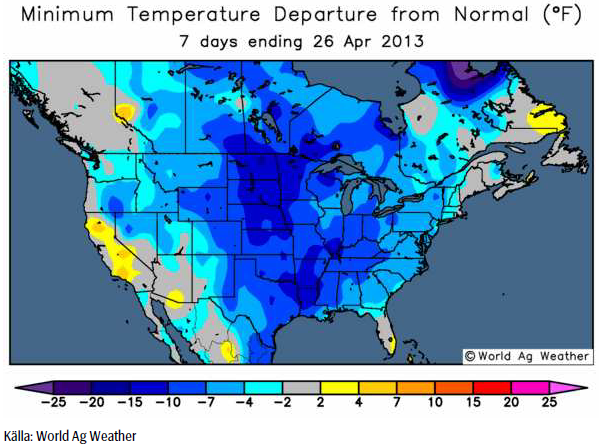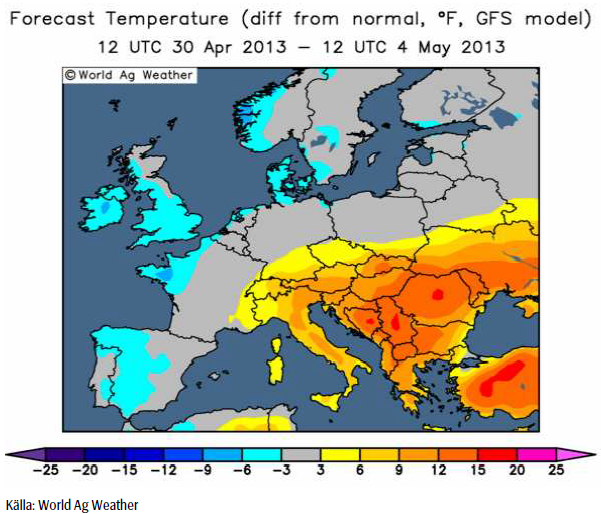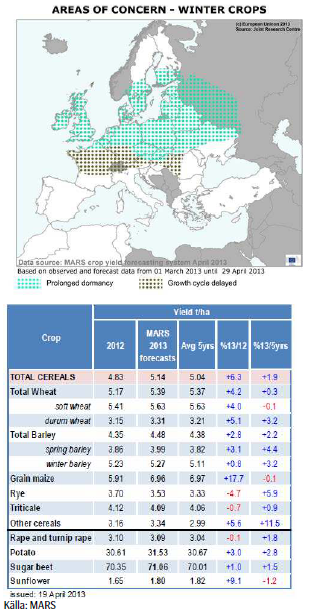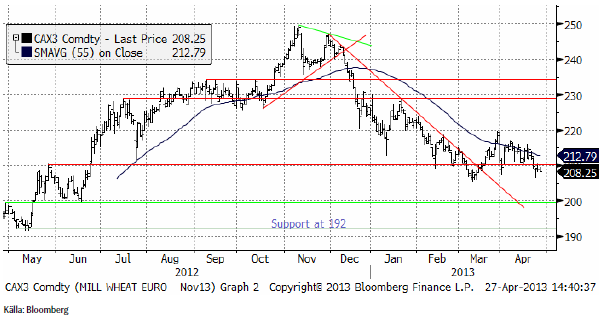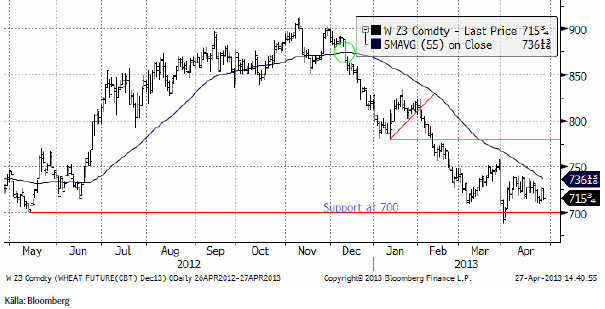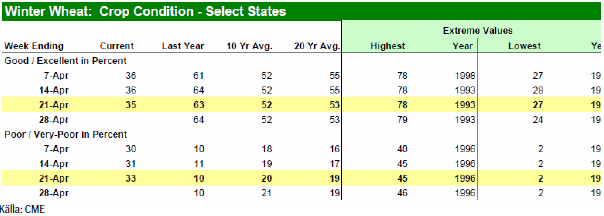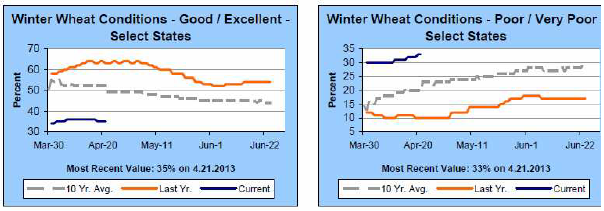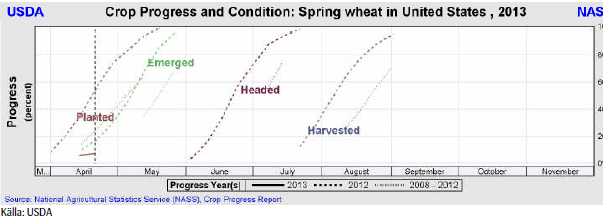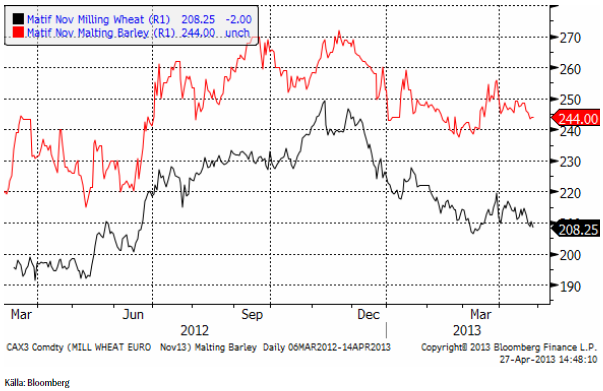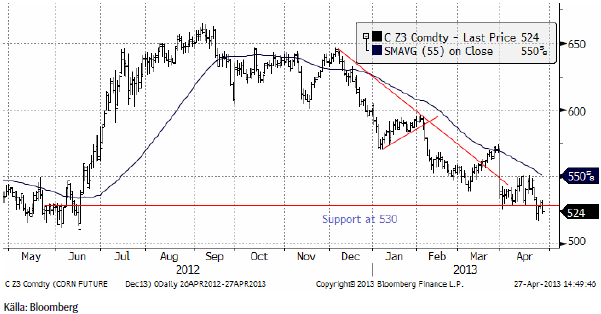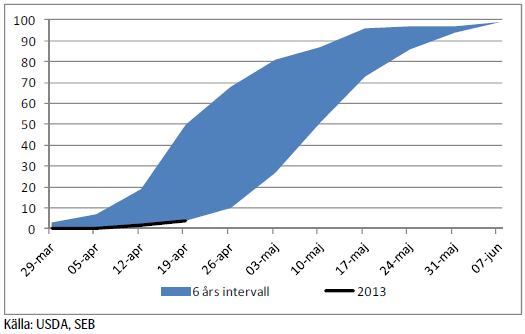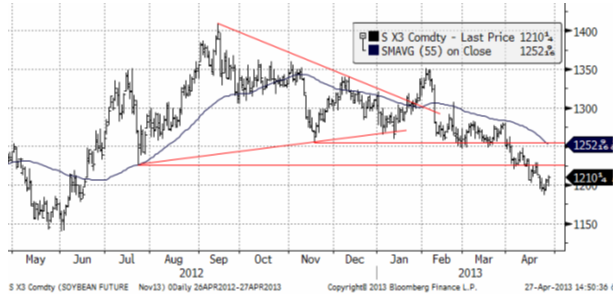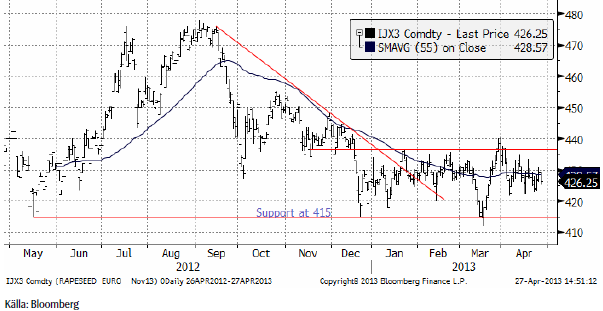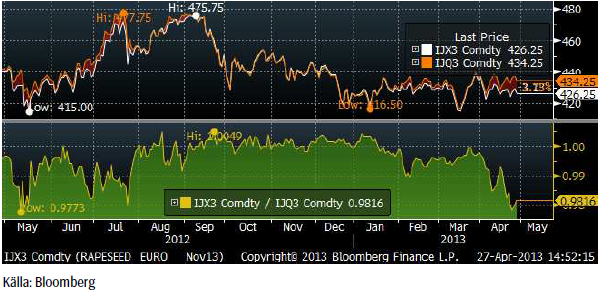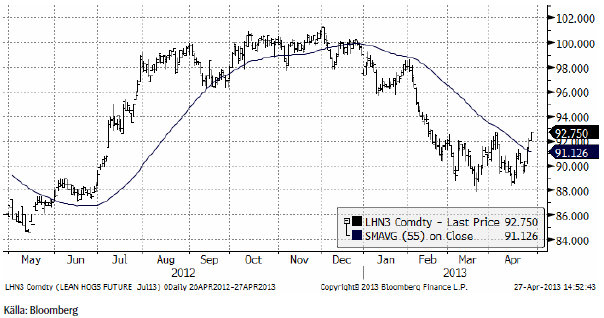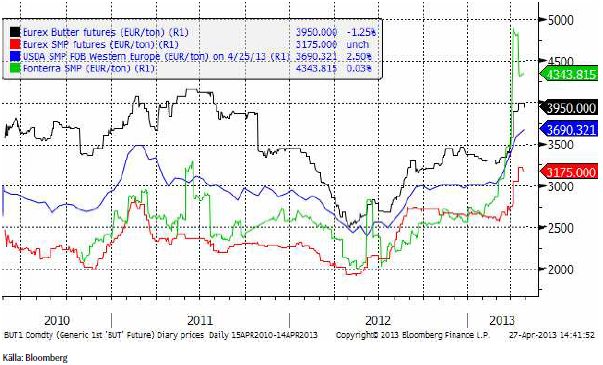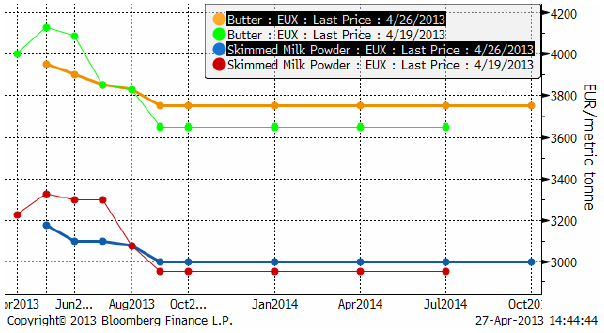Analys
SEB Jordbruksprodukter, 29 april 2013


 Sådden av majs i USA har inte kunnat ske på grund av den sena våren. Deadline, som anses vara den 10 maj närmar sig. Väderleksprognosen visar dock ett ”fönster” av gott väder, där sådden kan ske innan dess. De närmaste dagarnas väderutveckling kommer att ha ett avgörande inflytande över prisutvecklingen. Den kinesiska fågelinfluensan har sänkt konsumtionen av kyckling med upp till 80%. Det sänker efterfrågan på sojabönor i världen. Vi tror alltjämt på sjunkande priser på alla jordbruksprodukter. Grispriset i USA testar dock tekniska motståndsnivåer, möjligen just beroende på fågelinfluensan i Kina.
Sådden av majs i USA har inte kunnat ske på grund av den sena våren. Deadline, som anses vara den 10 maj närmar sig. Väderleksprognosen visar dock ett ”fönster” av gott väder, där sådden kan ske innan dess. De närmaste dagarnas väderutveckling kommer att ha ett avgörande inflytande över prisutvecklingen. Den kinesiska fågelinfluensan har sänkt konsumtionen av kyckling med upp till 80%. Det sänker efterfrågan på sojabönor i världen. Vi tror alltjämt på sjunkande priser på alla jordbruksprodukter. Grispriset i USA testar dock tekniska motståndsnivåer, möjligen just beroende på fågelinfluensan i Kina.
Odlingsväder
USA och Kanada var fortsatt kallare än normalt i veckan som gick. Prognosen för de kommande 7 dagarna är att detta ska bestå. Därefter för dag 7 till 14 väntas varmare väder, i synnerhet i Kanada.
I ett område från Tyskland och österut har varit varmare än normalt den senaste veckan. Prognosen för de närmaste 7 dagarna är normal temperatur i centrala och norra Europa. Däremot väntas det bli varmare än normalt i Italien, på Balkan och i Stillahavsområdet.
I Australien är det fortsatt väldigt torrt inför sådden som börjar snart.
MARS
Enligt den senaste rapporten från EU-kommissionens MARS-enhet så har den kyliga starten på våren i Europa, som har fått Mars månad att noteras som en av de kallaste någonsin, orsakat en kraftig försening – mer än en månad – gällande höstgrödornas utveckling, och dessutom försenat vårsådden (med undantag av Medelhavsområdet och runt Svarta Havet). Förseningar är särskilt tydliga i Storbritannien, men även i Tyskland och Frankrike. Trots detta gör de inga justeringar i sitt estimat för avkastning med motiveringen att det är för tidigt att uttala sig om en avkastning under genomsnittet.
Vete
Priset på november (2013) har hållit sig över 210 euro, som nu återigen fungerar som ett tekniskt stöd. Frågan är om priset ska bryta uppåt och testa 230.
Decemberkontraktet på CBOT ser mindre ”bullish” ut än grafen för Matif-vetet. Så som Chicagovetet handlats förefaller ett test av 700 cent på nedsidan vara troligare.
I onsdags drabbades Oklahoma av frost och det fick priset att gå upp temporärt.
Ser vi på den senaste veckan förändring av terminskurvorna, ser vi att priserna gått ner både i Europa och i USA och ungefär lika mycket oavsett löptid, undantaget gammal skörd. Weetabix har slutat producera vissa frukostflingor i väntan på ny skörd. Det saknas helt enkelt brittiskt vete av gammal skörd.
Måndagens crop condition-rapport ser vi i sammanfattning nedan.
Måndagens Crop Progress rapport från USDA visar att tillståndet för det amerikanska höstvetet har försämrats något. Sammantaget för de 18 största höstvete producerande så var 35% klassat som ”good/excellent” per den 21 januari, en marginell nedjustering från förra veckans 36%. Höstvete klassat som ”poor/very poor” justeras upp till 33% från förra veckans 31% och är en kategori som har ökat i bl.a Kansas och Colorado, men som har minskat kraftigt i South Dakota, Nebraska och Texas – även om klassificeringen ”good/excellent” i dessa stater fortfarande är urusla.
Sådden av vårvete gör minimala framsteg då endast 7% är avklarad i de 6 största staterna, vilket är en marginell ökning från förra veckans 6% och att jämföra med 52% för ett år sedan och det femåriga genomsnittet på 24%. Kallt väder och även snö har hindrat fältaktiviteter i vissa delar och hos topproducenten North Dakota har man ännu inte påbörjat sådden.
Ett tredje tecken på att skörden ligger efter i år är att bara 8% av höstvetet har gått i ax. Förra året den här tiden var det 42%.
StatsCanada skriver den 24 april att vårvetearealen ökar 14.4% till 19.4 miljoner acres. Det var mycket mer än marknaden väntat sig. Durum-arealen väntas också öka för tredje året i rad till 5.1 miljoner acres. I USDA:s prospective plantingsrapport för en månad sedan visades en minskning av arealen. Kanadensarna går alltså åt andra hållet.
Vi fortsätter att tro på sidledes eller lägre priser. Uppgångar bör ses som tillfällen att sälja.
Maltkorn
Priset på maltkorn med leverans i november har fortsatt att visa mer styrka än höstvetet / kvarnvetet på Matif.
StatsCanada rapporterar en korn-areal som är 2.2% mindre än förra året. Havrearealen ökar med 18.4%.
Lokala estimat pekar på väsentligt lägre sådd av maltkorn i Tyskland. På grund av den kalla och våta våren väntas arealen uppgå till 360,000 ha. Det är 40% mindre än förra året. Tyskland är EU:s största konsument av maltkorn och landet väntas behöva öka importen till 1 mt under 2013/14. Evergrain, den schweiziska mäklaren, estimerar Tysklands import i år (2012/13) till 265,000 ton.
Sådden av korn i USA ligger i linje med vad som är normalt. Tvärt emot vad som rapporterats på t ex Agrimoney. 23% är sått. Det var 43% förra året så här års, men 24% är det normala.
Det finns viss ”uppsidesrisk” för maltkornspriset med tanke på Kanadas och Tysklands mindre väntade skördar. Den senaste utvecklingen vi skriver om ovan, kan vi inte riktigt se fullt ut i starkare prisutveckling på maltkorn jämfört med vete.
Majs
Majspriset (december 2013) bröt stödet på 530 cent, rekylerade upp och slutade veckan nedåt igen. Trenden är stadigt nedåtriktad.
Sådden ligger kraftigt efter i USA. Den 19 april var endast 4% sått. Förra året var det 28% och det tidiga året 2010 var det 50%. En åkerareal stor som Belgien och Holland tillsammans borde ha varit sådd, men har inte blivit det på grund av det kalla vädret. Sådden har ännu inte börjats i den största producerande staten, Iowa, och inte heller i Colorado, Michigan, Minnesota, Nebraska, North Dakota, South Dakota eller i Wisconsin. I Illinois, Indiana och Ohio är sådden endast avklarad till 1%.
Nedan ser vi såddens framåtskridande i USA. 6-årsintervallet sträcker sig från 2007 till 2012.
Utvecklingen sker exakt lika långsamt som år 2008, ett år där priserna trots allt föll kraftigt. På grund av att vädret i veckan inte varit perfekt, kan man inte vänta sig att sådden kommit upp till mer än 6-10% nu i rapporten som kommer på måndagskvällen. Därefter väntas, som vi såg ovan under ”odlingsväder” bättre väder komma, vilket ger ett tillfälle att så. Sås majsen för sent, den 10 maj betraktas som en slags deadline, får varje försening en negativ effekt på avkastningen. De närmaste dagarnas väder är alltså avgörande för priset.
Väderleksrapporten säger att det kommer att gå bra. Därför tror vi alltjämt på fallande priser.
Sojabönor
Sojabönorna (november 2013) ligger i en stadigt sjunkande pristrend. Amerikans sådd av soja har inte kommit igång alls. Förra året var 6% sått redan. Den kinesiska fågelinfluensan har ökat i nyhetsflödet och det fjäderfä i Kina är närmast osäljbart vad vi kan förstå från nyhetsrapporteringen.
Den argentinska skörden är 56% klar, men bönderna håller inne med sin vara. BAGE estimerar skörden till 48.5 mt (USDA har den senat på 51.5 mt). Den argentinska staten har just klubbat igenom lagar som reducerar möjligheten för företag och privatpersoner att värna sin egendom gentemot staten.
Statsinkomsterna kommer till stor del från exportskatter på soja. Den argentinska peson handlas på gatan till halva den officiella växlingskursen. Presidentens socialistiska och värdenihilistiska politik ser ut att föra landet mot en mörk framtid.
Väderutvecklingen i USA och dämpad efterfrågan från Kina gör att vi tror att priset kommer att fortsätta falla och rekommenderar en såld position i sojabönor. 1150 cent är nästa målkurs.
Raps
Rapspriset (november 2013) ligger kvar på någorlunda hög nivå. En anledning är att skörden i Europa väntas bli ca 1 månad senare än normalt.
Förra veckan skrev vi om ”spreaden” mellan augustikontraktet och novemberkontraktet. Den prisskillnaden ligger fortsatt på en onormal nivå, som indikerar att många väntar sig ett högre pris på augusti (som för gammal skörd) än ny-skörds-kontraktet november. Vi tror att vädret kommer att fortsätta förbättras, så att augusti är säljvärt.
StatsCanada rapporterade i onsdags den 24 april att kanadensiska lantbrukare kommer att så 19.1 miljoner acres med canola. Det är 11% mindre än förra året och den första minskningen sedan 2006.
Det är ändå svårt att se att rapsmarknaden ska hålla sig så stark, medan priset på sojabönor faller. Vi fortsätter att rekommendera en såld position i raps. Den börjar dessutom bygga upp fallhöjd om och när ett brott av den tekniska stödnivån inträffar.
Gris
Grispriset (September 13) testar nu den nedåtgående trenden. Beroende på hur marknaden går i veckan, kan vi få en köpsignal från den tekniska analysen.
Mjölk
Eurexmarknaden gick ner i veckan som gick – på de korta kontrakten. De långa steg däremot både på SMP och smör.
I kursdiagrammet nedan ser vi priserna på Fonterras SMP, USDA:s prisnotering på SMP i Europa och Eurexbörsens pris, samt Eurex pris på smör. Alla priser är angivna i euro per ton.
Nedan ser vi terminskurvorna för smör och skummjölkspulver på Eurex i fredags vid börsens stängning och veckan innan.
SEB Commodities erbjuder ett litet ”prova-på” kontrakt som består av 0.5 ton Eurex-smör och 0.9 ton Eurex SMP. Ett paket som motsvarar 10 ton flytande mjölkråvara. Just nu är det underliggande värdet på ett sådant kontrakt drygt 33 000 kronor. Vi garanterar börspris eller bättre.
Den som vill följa priset på SMP på Eurex gör det via länken:
www.eurexchange.com/exchange-en/products/com/agr/14016/
Vi tycker att den här haussen på världsmarknaden skapar ett bra tillfälle att säkra via terminer.
[box]SEB Veckobrev Jordbruksprodukter är producerat av SEB Merchant Banking och publiceras i samarbete och med tillstånd på Råvarumarknaden.se[/box]
Disclaimer
The information in this document has been compiled by SEB Merchant Banking, a division within Skandinaviska Enskilda Banken AB (publ) (“SEB”).
Opinions contained in this report represent the bank’s present opinion only and are subject to change without notice. All information contained in this report has been compiled in good faith from sources believed to be reliable. However, no representation or warranty, expressed or implied, is made with respect to the completeness or accuracy of its contents and the information is not to be relied upon as authoritative. Anyone considering taking actions based upon the content of this document is urged to base his or her investment decisions upon such investigations as he or she deems necessary. This document is being provided as information only, and no specific actions are being solicited as a result of it; to the extent permitted by law, no liability whatsoever is accepted for any direct or consequential loss arising from use of this document or its contents.
About SEB
SEB is a public company incorporated in Stockholm, Sweden, with limited liability. It is a participant at major Nordic and other European Regulated Markets and Multilateral Trading Facilities (as well as some non-European equivalent markets) for trading in financial instruments, such as markets operated by NASDAQ OMX, NYSE Euronext, London Stock Exchange, Deutsche Börse, Swiss Exchanges, Turquoise and Chi-X. SEB is authorized and regulated by Finansinspektionen in Sweden; it is authorized and subject to limited regulation by the Financial Services Authority for the conduct of designated investment business in the UK, and is subject to the provisions of relevant regulators in all other jurisdictions where SEB conducts operations. SEB Merchant Banking. All rights reserved.
Analys
Tightening fundamentals – bullish inventories from DOE

The latest weekly report from the US DOE showed a substantial drawdown across key petroleum categories, adding more upside potential to the fundamental picture.

Commercial crude inventories (excl. SPR) fell by 5.8 million barrels, bringing total inventories down to 415.1 million barrels. Now sitting 11% below the five-year seasonal norm and placed in the lowest 2015-2022 range (see picture below).
Product inventories also tightened further last week. Gasoline inventories declined by 2.1 million barrels, with reductions seen in both finished gasoline and blending components. Current gasoline levels are about 3% below the five-year average for this time of year.
Among products, the most notable move came in diesel, where inventories dropped by almost 4.1 million barrels, deepening the deficit to around 20% below seasonal norms – continuing to underscore the persistent supply tightness in diesel markets.
The only area of inventory growth was in propane/propylene, which posted a significant 5.1-million-barrel build and now stands 9% above the five-year average.
Total commercial petroleum inventories (crude plus refined products) declined by 4.2 million barrels on the week, reinforcing the overall tightening of US crude and products.


Analys
Bombs to ”ceasefire” in hours – Brent below $70

A classic case of “buy the rumor, sell the news” played out in oil markets, as Brent crude has dropped sharply – down nearly USD 10 per barrel since yesterday evening – following Iran’s retaliatory strike on a U.S. air base in Qatar. The immediate reaction was: “That was it?” The strike followed a carefully calibrated, non-escalatory playbook, avoiding direct threats to energy infrastructure or disruption of shipping through the Strait of Hormuz – thus calming worst-case fears.

After Monday morning’s sharp spike to USD 81.4 per barrel, triggered by the U.S. bombing of Iranian nuclear facilities, oil prices drifted sideways in anticipation of a potential Iranian response. That response came with advance warning and caused limited physical damage. Early this morning, both the U.S. President and Iranian state media announced a ceasefire, effectively placing a lid on the immediate conflict risk – at least for now.
As a result, Brent crude has now fallen by a total of USD 12 from Monday’s peak, currently trading around USD 69 per barrel.
Looking beyond geopolitics, the market will now shift its focus to the upcoming OPEC+ meeting in early July. Saudi Arabia’s decision to increase output earlier this year – despite falling prices – has drawn renewed attention considering recent developments. Some suggest this was a response to U.S. pressure to offset potential Iranian supply losses.
However, consensus is that the move was driven more by internal OPEC+ dynamics. After years of curbing production to support prices, Riyadh had grown frustrated with quota-busting by several members (notably Kazakhstan). With Saudi Arabia cutting up to 2 million barrels per day – roughly 2% of global supply – returns were diminishing, and the risk of losing market share was rising. The production increase is widely seen as an effort to reassert leadership and restore discipline within the group.
That said, the FT recently stated that, the Saudis remain wary of past missteps. In 2018, Riyadh ramped up output at Trump’s request ahead of Iran sanctions, only to see prices collapse when the U.S. granted broad waivers – triggering oversupply. Officials have reportedly made it clear they don’t intend to repeat that mistake.
The recent visit by President Trump to Saudi Arabia, which included agreements on AI, defense, and nuclear cooperation, suggests a broader strategic alignment. This has fueled speculation about a quiet “pump-for-politics” deal behind recent production moves.
Looking ahead, oil prices have now retraced the entire rally sparked by the June 13 Israel–Iran escalation. This retreat provides more political and policy space for both the U.S. and Saudi Arabia. Specifically, it makes it easier for Riyadh to scale back its three recent production hikes of 411,000 barrels each, potentially returning to more moderate increases of 137,000 barrels for August and September.
In short: with no major loss of Iranian supply to the market, OPEC+ – led by Saudi Arabia – no longer needs to compensate for a disruption that hasn’t materialized, especially not to please the U.S. at the cost of its own market strategy. As the Saudis themselves have signaled, they are unlikely to repeat previous mistakes.
Conclusion: With Brent now in the high USD 60s, buying oil looks fundamentally justified. The geopolitical premium has deflated, but tensions between Israel and Iran remain unresolved – and the risk of missteps and renewed escalation still lingers. In fact, even this morning, reports have emerged of renewed missile fire despite the declared “truce.” The path forward may be calmer – but it is far from stable.
Analys
A muted price reaction. Market looks relaxed, but it is still on edge waiting for what Iran will do

Brent crossed the 80-line this morning but quickly fell back assigning limited probability for Iran choosing to close the Strait of Hormuz. Brent traded in a range of USD 70.56 – 79.04/b last week as the market fluctuated between ”Iran wants a deal” and ”US is about to attack Iran”. At the end of the week though, Donald Trump managed to convince markets (and probably also Iran) that he would make a decision within two weeks. I.e. no imminent attack. Previously when when he has talked about ”making a decision within two weeks” he has often ended up doing nothing in the end. The oil market relaxed as a result and the week ended at USD 77.01/b which is just USD 6/b above the year to date average of USD 71/b.

Brent jumped to USD 81.4/b this morning, the highest since mid-January, but then quickly fell back to a current price of USD 78.2/b which is only up 1.5% versus the close on Friday. As such the market is pricing a fairly low probability that Iran will actually close the Strait of Hormuz. Probably because it will hurt Iranian oil exports as well as the global oil market.
It was however all smoke and mirrors. Deception. The US attacked Iran on Saturday. The attack involved 125 warplanes, submarines and surface warships and 14 bunker buster bombs were dropped on Iranian nuclear sites including Fordow, Natanz and Isfahan. In response the Iranian Parliament voted in support of closing the Strait of Hormuz where some 17 mb of crude and products is transported to the global market every day plus significant volumes of LNG. This is however merely an advise to the Supreme leader Ayatollah Ali Khamenei and the Supreme National Security Council which sits with the final and actual decision.
No supply of oil is lost yet. It is about the risk of Iran closing the Strait of Hormuz or not. So far not a single drop of oil supply has been lost to the global market. The price at the moment is all about the assessed risk of loss of supply. Will Iran choose to choke of the Strait of Hormuz or not? That is the big question. It would be painful for US consumers, for Donald Trump’s voter base, for the global economy but also for Iran and its population which relies on oil exports and income from selling oil out of that Strait as well. As such it is not a no-brainer choice for Iran to close the Strait for oil exports. And looking at the il price this morning it is clear that the oil market doesn’t assign a very high probability of it happening. It is however probably well within the capability of Iran to close the Strait off with rockets, mines, air-drones and possibly sea-drones. Just look at how Ukraine has been able to control and damage the Russian Black Sea fleet.
What to do about the highly enriched uranium which has gone missing? While the US and Israel can celebrate their destruction of Iranian nuclear facilities they are also scratching their heads over what to do with the lost Iranian nuclear material. Iran had 408 kg of highly enriched uranium (IAEA). Almost weapons grade. Enough for some 10 nuclear warheads. It seems to have been transported out of Fordow before the attack this weekend.
The market is still on edge. USD 80-something/b seems sensible while we wait. The oil market reaction to this weekend’s events is very muted so far. The market is still on edge awaiting what Iran will do. Because Iran will do something. But what and when? An oil price of 80-something seems like a sensible level until something do happen.
-

 Nyheter4 veckor sedan
Nyheter4 veckor sedanUppgången i oljepriset planade ut under helgen
-

 Nyheter3 veckor sedan
Nyheter3 veckor sedanMahvie Minerals växlar spår – satsar fullt ut på guld
-

 Nyheter4 veckor sedan
Nyheter4 veckor sedanLåga elpriser i sommar – men mellersta Sverige får en ökning
-

 Nyheter2 veckor sedan
Nyheter2 veckor sedanOljan, guldet och marknadens oroande tystnad
-

 Nyheter2 veckor sedan
Nyheter2 veckor sedanJonas Lindvall är tillbaka med ett nytt oljebolag, Perthro, som ska börsnoteras
-

 Analys4 veckor sedan
Analys4 veckor sedanVery relaxed at USD 75/b. Risk barometer will likely fluctuate to higher levels with Brent into the 80ies or higher coming 2-3 weeks
-

 Analys3 veckor sedan
Analys3 veckor sedanA muted price reaction. Market looks relaxed, but it is still on edge waiting for what Iran will do
-

 Nyheter2 veckor sedan
Nyheter2 veckor sedanDomstolen ger klartecken till Lappland Guldprospektering


